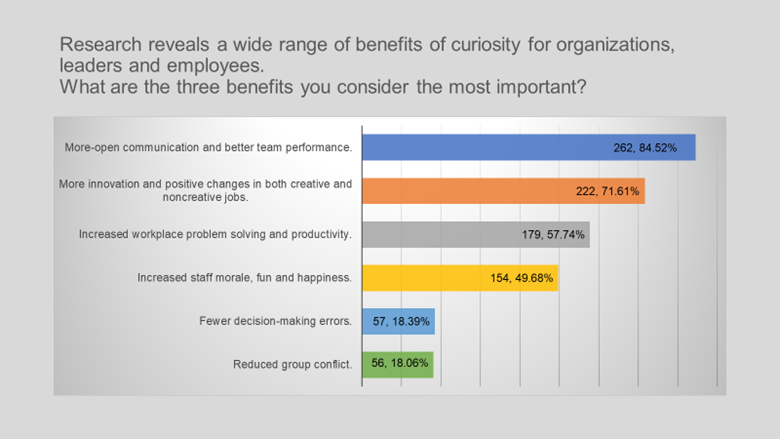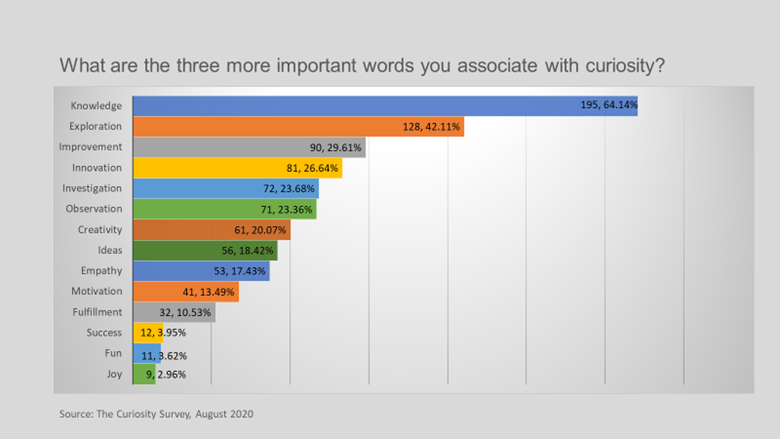
Make curiosity part of your identity and leadership journey says Julia Schmidt
Making you curious about curiosity
First things first: just what is curiosity? Simply defined, curiosity is an eager wish to know or learn about something.
During the last few months, I have been reading about curiosity. And just to make you as curious as I am about the topic, I want to share with you what research tells us about curiosity.
At five years of age, 98% of all children have no problem thinking divergently.
Three-year-olds, on average, ask their parents about 100 questions a day, every day! However, by the time they are ten to eleven years of age, they’ve pretty much stopped asking.
By the age of 25, only 2% of us can think outside the box. Curiosity seldom survives into adulthood.
While our brains may experience decline as we age, our curiosity remains intact, and may actually increase.
Curiosity encourages members of a group to put themselves in one another’s shoes and take an interest in one another’s ideas, rather than focus only on their own perspective.
Encouraging people to be curious generates workplace improvements.
Curiosity as a key skill
Curiosity is key because we are all aware that in today’s world, different ideas and experiences are crucial to enable growth. As a skill, it can be improved, developed, and integrated into our daily activities. Another encouraging reminder is that curiosity is an intrinsic trait, just as our need for food and water is.
I am one of those people who is interested in many things. I believe my creativity comes from my desire to learn new things, read, experience new environments, visit countries, and discover new cities and food recipes. When I’m at the beach, I rarely take refuge in my cellphone or books. I make this time an excellent occasion to watch the people around me, notice little things about them, and try to guess where they come from, or find out the language they speak. My curiosity just blossoms, it’s like positioning myself with something that captures my interest.
“Position yourself with something that captures your curiosity, something that you’re a missionary about.” ~ Jeff Bezos
My curiosity about curiosity motivated me to read more about the topic, conduct a survey among Executive Assistants, and write this article. My goal is to share with you the best takeaways from my readings; encourage you to strengthen your curiosity skills; and help you to build workplaces that cultivate curiosity.
“I really believe that curiosity is like a muscle that must be used in order to stay strong.” ~ Joe Colloway
We are often advised to increase our creativity by asking questions, stepping out of our bubble of safety, diversifying our interests, and being amazed by everyday things. But are we really incorporating these habits into our day-to-day lives?
“Never have the skills of learnability, agility, and adaptability been so needed” stated Jason W. Birkevold Liem in his article Reskilling: The Future Skill that is Needed Now. Even before the current world crisis, changing technologies and new ways of working were disrupting jobs and the skills employees need to perform their tasks. The coronavirus pandemic has made this question even more critical. Birkevold further says that “people who have the drive to develop will gain an edge over others. It will increase the likelihood of remaining employable and relevant.”
So, where does everything start? I believe it starts with our desire to know more, to learn what is needed, to discover new ways of doing things, being innovative, creative problem solvers. Research shows that it begins with our ability to be curious. Curiosity drives creativity and innovation. Curiosity is a learning tool that helps us discover everything we need to survive. Curiosity leads to more initiative-taking and better decision-making.
“I have no special talent. I am only passionately curious.” ~ Albert Einstein
There is no such thing as a stupid question
Do you believe that? Why do we often ask for excuses before asking questions? Many employees do not provide input to their managers or teammates for fear of looking stupid. How can we encourage curiosity in our workplaces if we are afraid of sharing our passion and ideas?
We know that innovation is at the top of many CEO’s lists for what they would like their employees to improve upon within their organizations. Therefore, an Executive Assistant – a CEO’s best business partner – has to lead by example when helping their executive improve organizational innovation. We should be the first to ask open-ended questions that require critical thinking, and then listen attentively to what we hear in response. If we embrace the fun in questioning, learning, exploring, and discovering; we can become integral to many innovative initiatives. With our curiosity skills, we can spark as many new ideas as we can imagine!
Many innovative breakthroughs came from questions such as:
- Why not?
- Why doesn’t this work?
- What are we missing?
- What if…?
- I wonder what happens when…?
- I wonder what we would get if we did A and B?
“Curiosity provokes a variation of the question ‘What if…?’ while providing the fuel that leads to creation.” ~ Diane Hamilton
Curiosity and Inclusive Leadership
In our roles as Executive Assistants, we need to be vigilant in developing our skill set in a way that allows us to foster strong partnerships with our executives, even as we grow in leadership throughout our careers.
In an interview for Harvard Business Review, Dr. Terri Cooper, principal and chief inclusion officer at Deloitte Consulting LLP, identified six signature traits of inclusive leadership. They are cultural intelligence, collaboration, commitment, courage, cognizance, and curiosity. She explained that “curiosity isn’t passive.” It is very active. Curiosity is about showing appreciative inquiry, bringing an open mindset and a true desire to know people. Leaders who show these traits actively seek the perspective of diverse others in ideation and decision-making. They have a true desire to know people, engage in a respectful and curious questioning to better understand others’ opinions. They listen attentively when others are voicing a point of view, encourage divergent thinking and opportunities to connect with a diverse range of people, and demonstrate an active interest in other cultures.
Curiosity and life-long learning
Arini Vlotman, in her article CQ – The Curiosity Quotient, mentions that in every team, company or group, there is often one individual that is always asking questions. “You can see the wheels turning in their minds and the sparks shooting, as they try and figure out a new, better, and more creative way of doing things. These people are what I call Curiosity Giants.” I want to be a Curiosity Giant! What about you?
In my book The Executive Secretary Guide to Building a Successful Career Strategy, I explained that our curiosity nurtures our commitment to learning. “Boost curiosity. It will keep your interest in deep reflection and continuous inquiry and learning. Learning happens at all life stages of development and happens not only in educational or professional settings.” To dig a little deeper, I distributed a curiosity self-assessment to help uncover what fuels passionate curiosity.
Curiosity self-assessment
Reflect on the ideas that energize and make you wonder.
- What are you curious about?
- What do you want or need to know more about?
- What would your executive or manager like you to know more about?
- What do you need to be curious about to grow professionally?
Cultivating a passionate curiosity is fundamental to becoming a Curiosity Giant. When we put curiosity at the heart of everything we do, we discover the unfamiliar in the familiar things of life. We elevate our common curiosity to a higher-level and promote journeys of life long learning.
What are Executive Assistants saying about curiosity?
In my survey, conducted in August 2020, 350 respondents from across 25 countries expressed the positive impact of curiosity in their career. They say that curiosity opens doors to knowledge and development, enables self-motivated growth, pushes them to experience new things, and challenges them to think differently. They also associate curiosity with an open mindset, and see it as being instrumental in building relationships of collaboration, empathy, and trust.


Context matters
When the environment in which people live and work provides the essential conditions and support for growth and development, people thrive. However, before we can experience this growth, we need to develop our curiosity skills. As many studies have suggested, while our brains may experience a decline with age, our curiosity remains intact and may actually increase as we grow older. Research also shows that positive enforcement and a supportive learning environment are essential elements of our journey from childhood to old age. Therefore, it is crucial for us to have environments that allow us to continually learn and grow throughout our lives.
When the conditions for creativity are poor, and the support is lacking, people struggle and seldom reach their full curiosity potential. Curiosity is a muscle that must be exercised and nurtured. So, we must make curiosity an integral part of our identity and our leadership journey. As leaders in our profession, we need to model inquisitiveness, encouraging curiosity within our teams and organizations.
How can Executive Assistants help to create the right workplace atmosphere, promoting environments that foster curiosity, a necessary component for innovation?
Surround yourself with curious people
Who are the most curious friends or colleagues you have? Start local. Then extend the group. Who are the other curious people you would like to know? Find out where the curious people are. Attend the events they attend. Follow them on social media channels. Schedule a chat with them. Interview them. Get inspired by their passionate curiosity. Research has shown that the quality of your relationships significantly influences the quality of your learning.
Have a diverse network
In your workplace, look for colleagues who are from different cultures and countries. If you have a diverse workforce, benefit from it! Social media channels are great tools for connecting people and are a starting point for building relationships.
Create team activities that encourage critical thinking
When we let people express their ideas, contribute solutions, and share their perspective, we create an inclusive, safe work environment that embraces diversity and curiosity.
Welcome new ideas and opinions with an open mind
Take notes, thank people for sharing their opinions. Let your body language show that you are actively listening and being inclusive. As a team leader, use questions such as “If we thought about this problem differently, what would that look like?” And, to ensure that opinions are celebrated, say “Excellent! I never would have thought of that!” to encourage people to express their curiosity. Reward their questioning. “I like your audacity! How could we make that work?”
Embrace failure as an opportunity to learn
When you allow people to question, you promote inclusion and robust problem-solving. Test different solutions, even if some of them aren’t the best options. This will increase knowledge, understanding, and development for everyone. And, as Harry Potter series author J. K. Rowling said, “It is impossible to live without failing at something. Unless you live so cautiously that you might as well not have lived at all, in which case you have failed by default.”
Ask the WHYs, always
When I participate in meetings, I always do a pre-study and prepare 2-3 questions I can ask to gain knowledge of the discussion topic. Make asking questions a habit. Make curiosity part of your identity. In your meetings, include a slide with a big WHY? on it. This fosters questioning from the entire group.
Make people believe there are NO stupid questions
In your meetings, try asking the questions listed in the There is no such thing as a stupid question section. Help others to practice this type of inquisitiveness and make asking questions a habit! Start small to help teammates feel confident and comfortable. You will be creating what I call inclusive-curiosity-meetings.
Find a favorite open question to encourage people to share their opinions
What about: “And what else?”
“The more serious you are about learning, the more questions you should ask.” ~ James M. Kouzes and Barry Z. Posner
In conclusion
Maintaining a sense of wonder is fundamental to creativity and innovation. Effective Executive Assistants are looking for ways to nurture curiosity and fuel learning and discovery. With curiosity comes creativity, learning, improvement, innovation, empathy, inclusion, and growth. As the organizational psychologist and professor Tomas Chamorro-Premuzic stated, “Curiosity is the ultimate tool to help us produce the solutions we need to solve the complex problems we face.”
___________________
References
Articles: The Business Case for Curiosity, The Five Dimensions of Curiosity, From Curios to Competent in Harvard Business Review September-October 2018
Cracking the Curiosity Code: The Key to Unlocking Human Potential, by Diane Hamilton
The Curiosity Survey conducted by Julia Schmidt, August 2020












